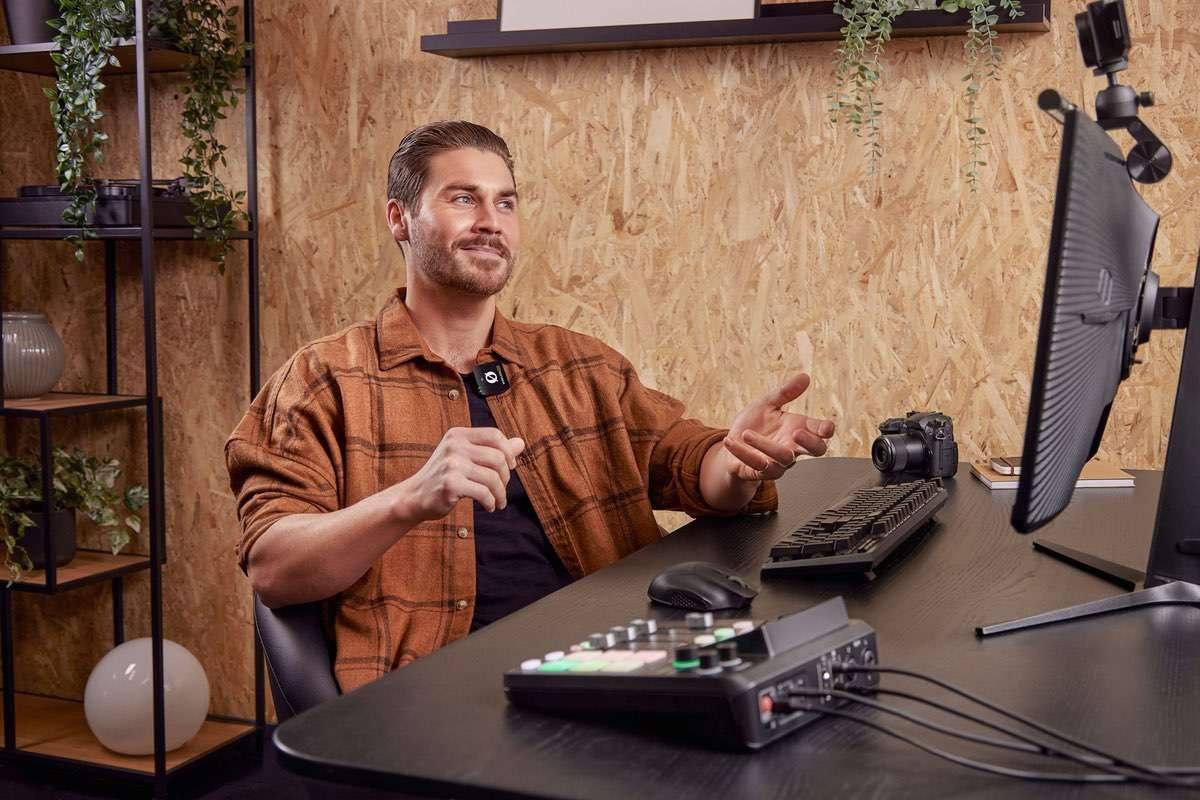Australian audio brand RØDE has been turning out some exciting products lately. The latest to arrive on my desk for review is the RØDECaster Duo. This is a smaller version of the very successful RØDECaster Pro II and has two combi XLR/TRS inputs instead of four of its larger sibling. The Duo has four physical faders instead of Pro II’s six, but in most other ways, it’s almost identical in its scope and performance
The RØDECaster Duo is ideal for someone who doesn’t need to use four XLR microphones simultaneously. Many podcasts are one-on-one affairs, so two XLR inputs are adequate for many podcasters. The XLR inputs feed into RØDE’s superb Revolution preamps, putting the Duo at the top of my list for small-scale podcast mixers.
Like its larger sibling, the RØDECaster Duo is built around the same quad-core audio processor that the Pro II uses. RØDE regularly expands the features of the RØDECaster with free ‘over-the-air’ firmware updates that can be downloaded using Wi-Fi or Ethernet connections.
RØDE is constantly improving and extending the features of the RØDECaster range, including a recent update that enables the RØDECaster Pro II and Duo to connect with RØDE’s wireless microphone transmitters like the RØDE Wireless GO II and the RØDE Wireless ME, making it easy to add a couple of extra mics when your podcast has more guests.
The Duo has four physical faders and three virtual faders. There is a total of eight inputs that can be mapped to any of the faders (physical or virtual). You could, for example, have one fader for the presenter’s microphone, a second for the USB coming from the host computer, a third for a mobile phone via Bluetooth, while the fourth could be for the six SMART Pads that are included with the RØDECaster Duo.
SMART Pads are colored squares that can be pressed to trigger jingles, stings and music beds stored in the Duo’s memory. Additionally, effects like reverb or echo can be applied to a SMART Pad, enabling special effects to be applied instantly. SMART Pads can even be set up to trigger Midi commands to external software. The larger RØDECaster Pro II has eight SMART Pads with eight banks, offering 64 separate sounds or effects available at the touch of a pad.
The Duo has six SMART Pads with eight banks which still provides a healthy 48 separately stored sounds, effects or actions. Whatever is stored in each SMART Pad can be saved as a show so that each podcast can be saved to memory with its own jingles and sound effects. It all works well and it’s even possible to record a voice track or sound effect directly to a SMART Pad using the Duo.
At the heart of the RØDECaster Duo is a large color LCD touchscreen with all the menu settings and displays you need to produce a podcast or record music. The screen provides access to RØDE’s VoxLab processor, which includes APHEX effects. The settings can also be accessed using RØDE Connect software on Mac or Windows PCs.
Effects can be added to an input signal to apply compression and other enhancements. All the APHEX settings can be stored on a per-show basis which is handy for different voices needing different levels of compression or other classic APHEX effects like Big Bottom and Exciter. It’s incredibly versatile and includes other tools like noise gates and limiters.
As well as offering two USB connections for two host computers, the RØDECaster Duo can also record podcasts to a microSD card that fits into the Duo’s card slot. Programs or recording sessions can be stored as a combined stereo track or 14-separate tracks, which can be edited later using a computer.
At this point, I want to pay special praise to RØDE’s Revolution microphone preamps on the Duo. These preamps deliver superb audio quality with almost any microphone, instrument, headset, or line-level source. RØDE designed its Revolution preamps from the ground up, offering ultra-low-noise and high gain. These preamps can drive even the most demanding microphones without boosters or lifters. They can even coax enough gain from the notoriously insensitive Shure SM7B or RØDE PodMic.
Like the RØDECaster Pro II, the Duo is powered by a USB-C power supply. Although a power supply unit ships with the Duo, almost any USB-C power supply can be used, or even a power bank, as long as it can handle 9V 3A of output. The Duo can then be used almost anywhere, even without a mains power supply. This versatility can be combined with a battery-powered 5G Mi-Fi router and you can have an outside broadcast studio in the middle of nowhere.
Other features I enjoyed about the Duo include the return of the front-mounted 3.5mm headset input, which was missing from the RØDECaster Pro II. There are two other headphone outputs at the rear of the unit for use by guests. The person driving the desk can choose to silence inputs or even use talkback to speak to a guest without the auido being relayed to the recording or the host computer.
The great thing about the RØDECaster Duo and its larger sibling is that they can evolve with future firmware upgrades. It’s fair to say that the RØDECaster Pro II did have a few teething problems when it originally launched, but RØDE has diligently ironed out the bugs and added new features along the way. In the future, we can expect support for USB microphones and maybe even a SIP codec so that users can broadcast directly from the Duo.
Plenty of other features and functions are included with the Duo; far too many to list here. The beauty of the RØDECaster ecosystem is that you are always learning new ways of doing things. There’s an audio routing table to assign a mix minus setting to any output so a remote contributor doesn’t get an echo of their signal.
The options to customize the Duo’s settings are almost unlimited and include plenty of presets for various microphone types and instruments. Thanks to the dual USB interface, you can connect two computers simultaneously, one for a Zoom call and another for recording the show. It’s like a Swiss Army knife for podcasters.
Verdict: The RØDECaster Duo is a superb and physically smaller version of the RØDECaster Pro II. It has so many options and features that the user’s imagination limits its use. Until now, my favorite kit for a two-hander podcast was the Focusrite Vocaster, but I think the Duo offers so much more for a very reasonable price premium. RØDE has created a mini studio with a small footprint ideal for broadcasting, live streaming, or recording podcasts and music performances. The RØDE Revolution preamps are undoubtedly the star of the show and the best I’ve used so far. There’s not much the Duo can’t do. Best of all, it won’t take up all your valuable desk space. Highly Recommended.
Pricing & Availability: The RØDECaster Duo is available now and costs $499 / £569 / €599.
More info: rode.com
Tech Specs:
- Frequency range for mics and monitors: 20Hz – 20kHz.
- Microphone input impedance: 4KΩ.
- Instrument input impedance: 1MΩ.
- Preamplifier gain range: 0 – 76dB.
- Equivalent noise: -131.5dBV (A-weighted).
- Line output maximum level: 4dBu.
- Headphone output power: 250mW.
- Power requirements: USB-C PD (9V, 3A).
- Analog audio output connectivity: 2 x combo jack (mic, instrument, line) / 1 x 3.5 TRRS headset jack (I/O).
- USB Interface 1: 1 x 2-in/14-out multichannel device, 1 x 2-in/2-out with mix-minus.
- USB Interface 2: 1 x 2-in/2-out with mix-minus.
- Bit depth: 24-bit.
- Sample rate: 48kHz.
- Recording storage: microSDHC, microSDXC, USB-C removable drive (exFAT — minimum 100MB/s).
- Data transfer: USB 3.0 SD card reader 130MB/s.
- Network connectivity: Wi-Fi 802.11g/n/ac 2.4GHz and 5GHz, Ethernet 100/100.
- Internal storage (GB): 4GB (SMART pads).
- OS Requirements: macOS 10.15 or later, Windows 10 Version 1803 or later, Windows 11.
Read the full article here




